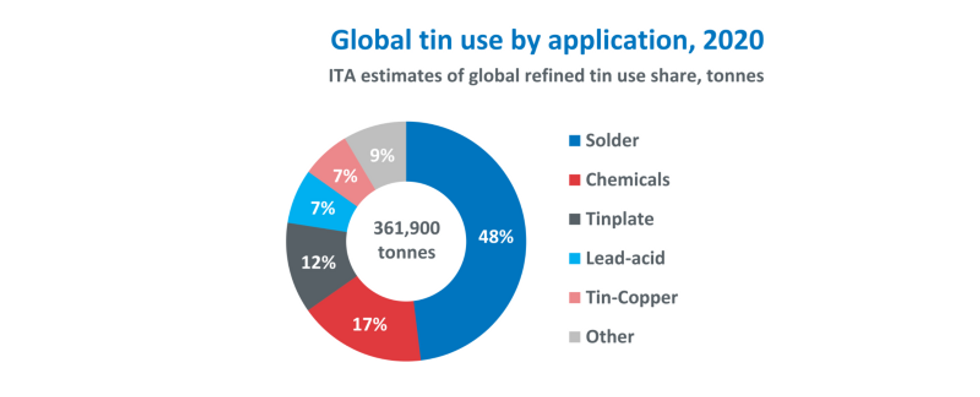Uses for Tin: Solder, Batteries and More
Tin’s interesting characteristics mean that there are many uses for tin. Learn about them here.

Largely produced in China, Indonesia and Peru, tin has a wide range of industrial applications.
The many uses of tin are directly linked to the silvery-white industrial metal’s myriad positive characteristics, including the fact that it is highly malleable, ductile and not easily oxidized in air.
Tin is also lightweight, durable and fairly resistant to corrosion. Those qualities make tin a good candidate for use in solders, as well as tinplate, chemicals, brass and bronze and other niche applications.
Understanding the many uses for tin is essential for investors interested in the metal. After all, in order to get a grasp of tin supply and demand dynamics, it’s important to know what exactly tin is used for, and how much tin those applications require. With that in mind, here’s a brief overview of the various uses for tin.
Uses for tin: Solder
As the above chart from the International Tin Association shows, tin is mainly used in the production of solder. In 2020, solder accounted for nearly half of tin consumption at an impressive 48 percent. This is a long-running trend, as approximately 50 percent of tin output has gone toward solder since 2005.
Solder is a fusible metal alloy that’s used to join metal workpieces. It can be made in various ways, but often is a lead-tin alloy. In these alloys, tin concentrations range from 5 to 70 percent by weight, with tensile and shear strengths increasing at higher levels of concentration.
Uses for tin: Chemicals
The next most used application for tin is in chemicals. In 2020, 17 percent of tin went towards chemical compounds of tin, with organotin compounds, the most widely used worldwide, taking the largest share.
But what exactly are organotin compounds? Explained most simply, they are chemical compounds based on tin with hydrocarbon substituents. Typically, these compounds are used in the manufacturing of food packages, paint, pesticides, plastics and plastic pipes.
Uses for tin: Tinplate
Tinplate is the product of the tinning process, where metals such as iron and steel are coated with tin to create a lightweight, corrosion-resistant finish. The end product is suitable for roofing and walling material. Terneplate is similar to tinplate, but refers to iron or steel that that’s been coated with tin as well as lead for added durability.
Tin’s resistance to corrosion is what makes it important for tin plating, and the process has a long history — it was first employed in the early 1800s, when tin-plated cans were created for preserving food. More recently, tinplate accounted for 12 percent of tin consumption in 2020 — a sizable chunk, but well behind solder.
Uses for tin: Lead-acid batteries
Next up is the use of tin in lead-acid batteries. In this application, the industrial metal is used in positive lead-calcium battery grids to improve casting and cycling performance, especially in automotive batteries. Tin is employed in the negative grid, as well as in lead-tin alloy posts and straps connecting the grid. In 2020, this segment of the market accounted for 7 percent of global tin consumption.
Uses for tin: Tin-copper alloys
As mentioned, tin can be alloyed with lead to make solder. However, lead isn’t the only metal that tin can be alloyed with; in fact, it’s most commonly alloyed with copper. Like lead-acid batteries, tin-copper alloys also represent 7 percent of tin demand.
One oft-discussed alloy of tin and copper is bronze, which is mostly copper and contains only 12 percent tin. Others include pewter, which is 85 to 99 percent tin, as well as bearing metal, which also has high tin content.
Brass is a bit of a different story. It’s an alloy made of copper and zinc, with the proportions of those metals varying depending on the manufacturer's requirements. Tin is also present in small amounts in some types of brass.
This is an updated version of an article first published by the Investing News Network in 2016.
Don't forget to follow us @INN_Resource for real-time updates!
Securities Disclosure: I, Melissa Pistilli, hold no direct investment interest in any company mentioned in this article.
- 5 Key Tin Facts Investors Should Know | INN ›
- 10 Largest Producers of Tin | INN ›
- How to Invest in Tin | INN ›
- Tin’s Critical Role in the Battery Supply Chain ›

